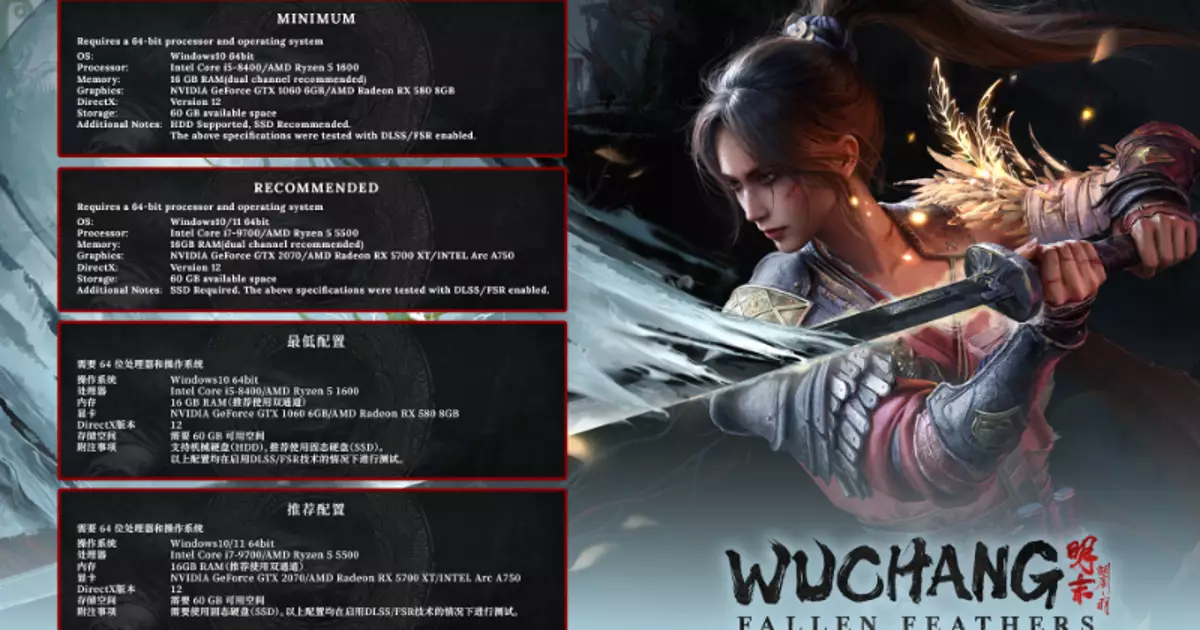In the realm of action RPGs, where dark, gothic atmospheres often dominate, Wuchang: Fallen Feathers segments itself as a uniquely vibrant and culturally rich experience. Set against the backdrop of the Ming dynasty, the game intertwines traditional Chinese mythology with a high-octane, combat-driven narrative. Unlike many titles that lean heavily on Western horror influences, Wuchang offers a fresh perspective, blending myth with innovation. Its visual updates, aimed at distancing itself from the Bloodborne comparisons, demonstrate a dedication to creating a world with its own identity—less oppressive, more enthralling. The game’s environment, Shu, presents a complex landscape of chaos and beauty, where plague-ridden streets and feathered monstrosities coexist in a haunting dance. Such a setting, paired with fluid combat mechanics and a compelling storyline, signals a significant leap forward for Chinese-developed titles on the global stage.
Technical Expectations and Hardware Realities
Wuchang’s system requirements paint a picture of a game accessible to a broad audience, yet powerfully capable of delivering impressive visuals. Requiring only an Intel Core i5-8400 or AMD Ryzen 5 1600, with 16GB of RAM, players can expect a smooth experience without chasing bleeding-edge hardware. The recommended specs elevate this slightly, advocating for a GeForce RTX 2070 or Radeon RX 5700 XT, and most notably, the mandatory SSD emphasizes a need for faster load times and smoother gameplay. This is notable because it signals the developers’ confidence in delivering high-quality visual fidelity without demanding the most cutting-edge systems, fostering inclusivity. The mention of Nvidia’s DLSS 4 support underlines an emphasis on performance optimization through AI-powered rendering enhancement—making it not only more beautiful but also easier to run for those with mid-tier machines.
However, these specifications also reveal a broader industry trend: modernization isn’t exclusively reserved for ultra-high-end hardware. Instead, the game aims to bridge the gap, making an exciting, visually stunning experience attainable for many. This strategic move might help Wuchang carve out a niche among mainstream gamers and die-hard enthusiasts alike, balancing quality and accessibility.
Gameplay Depth and Narrative Choices
Wuchang doesn’t settle for mere combat prowess. The game promises a layered experience, where players unlock new abilities using “Red Mercury,” an intriguing resource hinting at dark, perhaps illicit origins. These upgrades are essential, not only to beef up Wuchang’s power but to assist her in navigating the treacherous world filled with both feathered enemies and monstrous envoys of disease. The narrative’s core—piecing together a forgotten past amidst a plague of feathers—transcends simple hack-and-slash gameplay. It invites players into a web of decisions, secrets, and alliances, ultimately leading to multiple endings.
This design philosophy champions replayability and personal agency. Every choice influences the unfolding story—trust the wrong ally, ignore a hidden truth, or pursue a different path. As such, Wuchang elevates itself from a traditional action game into a narrative-driven experience where player decisions carry weight. It positions the game as not merely a combat sandbox, but a deeply immersive story rooted in Chinese mythology, history, and mythic symbolism, making each playthrough a unique journey of discovery.
My Personal Take: A Bold Step Forward
From my critical perspective, Wuchang’s combination of cultural richness, strategic visual updates, and robust gameplay mechanics marks it as a standout in the crowded action RPG genre. Unlike many titles that are content to imitate Western successes—often losing their unique charm in translation—Wuchang embraces its origins with pride. The integration of Chinese folklore, combined with modern gameplay enhancements, signals a meaningful shift toward more diverse storytelling in gaming.
Furthermore, its approach to system requirements and hardware support demonstrates a commendable understanding of its audience: players with mid-range PCs shouldn’t be left behind in the quest for beautiful, fluid worlds. The incorporation of DLSS 4 technology is a smart move, balancing graphical fidelity with performance. It demonstrates a forward-thinking attitude that aligns well with the game’s ambitions of aesthetic appeal and technical accessibility.
That said, the game’s reliance on combat, with boss fights and upgrade systems, risks falling into familiar gameplay patterns unless executed with fresh mechanics and narrative surprises. The true test will be whether Wuchang manages to innovate beyond its mythic veneer and deliver a memorable experience that champions cultural storytelling and engaging gameplay equally.
Wuchang: Fallen Feathers embodies the promising evolution of Chinese action RPGs, blending tradition with innovation, accessibility with depth. It’s a title that suggests more than mere spectacle—a potential for storytelling, cultural pride, and gameplay ingenuity that could elevate the genre in unexpected ways.


Leave a Reply